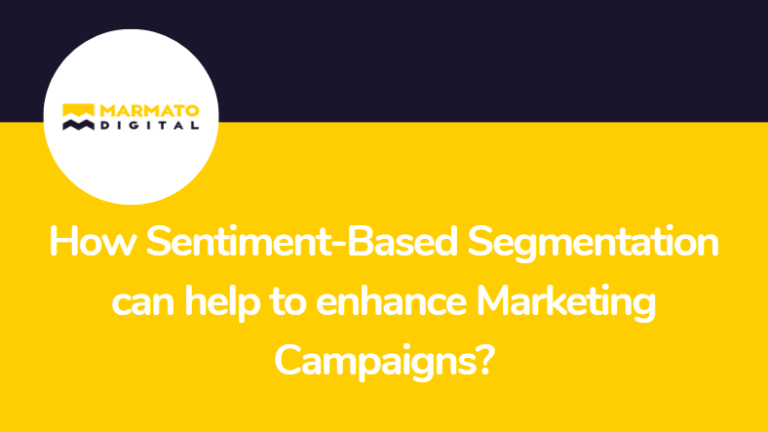In today’s competitive market, understanding your customers goes beyond just knowing their demographics or purchase history. Sentiment-based segmentation is an advanced approach that categorizes customers based on their emotions, helping brands create more personalized and effective marketing campaigns.
Unlike traditional segmentation, which relies on factors like age, location, or past behaviors, sentiment-based segmentation uses AI and social listening tools to analyze customer opinions, reviews, and online conversations. This allows you to identify whether customers feel positive, neutral, or negative about your brand and respond accordingly.

Why does this matter? Because emotions drive decisions. A happy customer might respond well to loyalty rewards, while a frustrated one may need personalized support. By using sentiment analysis, you can tailor the messaging, improve engagement, and build stronger customer relationships, resulting in higher satisfaction and better marketing performance.
What is Sentiment-Based Segmentation?
Sentiment-based segmentation is a marketing strategy that categorizes customers based on their emotions, rather than just demographics or behavior. It analyzes how people feel about a brand, product, or service, whether they are positive, neutral, or negative, to create more personalized and effective marketing campaigns.
This approach relies on advanced technologies like Artificial Intelligence (AI), Natural Language Processing (NLP), and social listening to analyze customer feedback from sources such as social media, online reviews, emails, and surveys. AI and NLP help detect tone, emotion, and context in customer conversations, while social listening tracks brand mentions and sentiment trends across digital platforms.
Benefits of Sentiment-Based Segmentation for Marketing Campaigns:
1. Improved Personalization:
By understanding customer emotions, brands can deliver content that truly resonates. Happy customers can receive loyalty rewards or exclusive deals, while frustrated customers can get personalized support or solutions, making interactions more relevant and effective.
2. Better Customer Engagement:
When marketers know how customers feel, they can send the right message at the right time. For example, a positive sentiment can trigger an upsell offer, while a neutral sentiment might call for educational content to build trust. This leads to stronger connections and higher response rates.
3. Crisis Management:
Negative sentiment can spread quickly, damaging a brand’s reputation. Sentiment-based segmentation helps businesses identify dissatisfied customers early and take proactive steps, such as personalized outreach or issue resolution, to turn negative experiences into positive ones.
4. Brand Advocacy:
Customers who frequently express positive sentiment can be nurtured into brand advocates. By identifying and engaging with these loyal fans through VIP offers, referral programs, or exclusive content, brands can encourage them to share their enthusiasm and attract new customers.
How to Implement Sentiment-Based Segmentation in Your Marketing Strategy?
A. Collecting Sentiment Data:
To segment customers based on their emotions, brands first need to gather sentiment data from various sources. Social media listening tools like Brandwatch, Sprout Social, and Hootsuite help track online conversations and brand mentions. AI-powered sentiment analysis can also be applied to emails, surveys, and customer reviews, detecting emotions in customer feedback.
B. Categorizing Sentiments for Targeted Marketing:
Once sentiment data is collected, it’s important to categorize customers based on their emotional state:
- Positive Sentiment: Loyal customers can be rewarded with exclusive offers, discounts, or VIP experiences to encourage repeat business.
- Neutral Sentiment: Customers who are undecided or inactive can receive educational content, testimonials, or product demos to build trust and engagement.
- Negative Sentiment: Dissatisfied customers should be addressed with personalized support, special offers, or proactive solutions to improve their experience and prevent churn.
C. Integrating Sentiment Data into Marketing Automation Tools:
To make sentiment-based segmentation actionable, brands can integrate sentiment data into marketing automation platforms like Marketo, Eloqua, or SFMC. These tools enable:
- Dynamic audience segmentation based on real-time sentiment changes.
- Automated email and SMS campaigns triggered by customer emotions.
Personalized ad campaigns tailored to customer sentiment trends
Use Case: Using Social Listening to Turn Negative Feedback into Brand Loyalty
Scenario:
A popular online fashion retailer notices a spike in negative comments on social media about delayed deliveries and poor customer service. Many frustrated customers are tweeting about their bad experiences and leaving negative reviews.
How Social Listening Helps:
Using a social listening tool like Brandwatch or Sprout Social, the retailer tracks these complaints in real time. The system flags negative sentiment, allowing the customer support team to quickly identify and respond to unhappy customers.
Steps Taken to Address the Issue:
- Immediate Response: The company replies publicly to each complaint, acknowledging the issue and inviting customers to discuss their concerns via direct message.
- Personalized Solutions: Affected customers receive a discount coupon for their next purchase and free expedited shipping on future orders.
- Process Improvement: Based on the feedback, the company improves its order tracking system and enhances customer support availability.
- Follow-Up Engagement: The brand follows up with customers a few weeks later to ensure their experience has improved and offers a loyalty reward for their patience.
Results:
- Many unhappy customers appreciate the quick response and resolution, changing their negative perception of the brand.
- Several customers update their reviews, sharing their positive turnaround experiences.
- The brand not only regains lost trust but also builds long-term customer loyalty through improved service.
Challenges and Considerations:
While sentiment-based segmentation offers great benefits, it comes with challenges that marketers must address to ensure success.
- Ensuring Data Accuracy in Sentiment Analysis:
AI-powered sentiment analysis isn’t perfect; it can sometimes misinterpret sarcasm, slang, or mixed emotions in customer feedback. To improve accuracy, businesses should combine AI tools with human review and continuously refine their sentiment models. - Avoiding Over-Personalization That May Seem Intrusive:
While personalization improves engagement, too much personalization can feel invasive. Customers may feel uncomfortable if brands seem to know too much about their emotions or online activity. To avoid this, marketers should focus on context-appropriate messaging and ensure transparency in how customer data is used. - Balancing Automation with Human Interaction for a Better Customer Experience:
Automation helps brands respond quickly, but a human touch is still essential for building trust. For example, while AI chatbots can handle simple customer complaints, human agents should step in for complex or emotional issues. Finding the right mix of automation and personal interaction ensures a seamless and customer-friendly experience.
Conclusion:
Sentiment-based segmentation is a powerful way to improve marketing campaigns by understanding and responding to customer emotions. By categorizing audiences based on positive, neutral, or negative sentiment, businesses can create more personalized, engaging, and effective marketing strategies.
Using AI-powered sentiment analysis and social listening tools, you can enhance customer engagement, manage crises, and build brand loyalty. However, to succeed, you must ensure data accuracy, avoid over-personalization, and balance automation with human interaction.
Unlock Deeper Customer Insights with Sentiment-Based Segmentation!
Subscribe to Newsletter
Get our latest blogs directly to your inbox.

